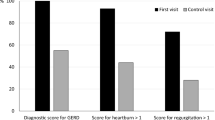Abstract
Recurrent abdominal pain (RAP) in children is generally believed to be functional. In practice, many children with RAP become pain-free with laxative therapy. The aims of the study were to establish the role of (occult) constipation in RAP and to investigate whether patients diagnosed with (occult) constipation could be identified by history and physical examination. During 2 years, all patients (age 4–16 years, secondary referral) fulfilling Apley criteria of RAP were included. After exclusion of gastrointestinal infections and food intolerance, laxatives were advised when pain persisted. (Occult) constipation was defined as ‘abdominal pain disappearing with laxative treatment and not reappearing within a 6 month follow up period’; ‘occult constipation’ was diagnosed in patients who did not fulfil the Rome criteria of constipation. Two hundred children (87 M; median age 8.8 years) were evaluated. (Occult) constipation was found in 92 patients (46 %). Of these, 18 had considerable relief of pain when treated for a somatic cause but experienced complete relief only after laxative measures; they were considered to have two diagnoses. Using multivariate analysis, a simple model was developed with cystitis in past history, early satiety and flatulence as predictors for (occult) constipation. The risk of (occult) constipation ranged from 18/58 if no predictor was present to 4/4 if all three were present. Conclusion: Laxatives played a pivotal role in the recovery of patients with RAP. We developed a simple model to identify patients at risk of having (occult) constipation.
Similar content being viewed by others
References
Apley J, Naish N (1958) Recurrent abdominal pains: a field survey of 1,000 school children. Arch Dis Child 33:165–170
Boccia G, Buonavolonta R, Coccorullo P, Manguso F, Fuiano L, Staiano A (2008) Dyspeptic symptoms in children: the result of a constipation-induced cologastric brake? Clin Gastroenterol Hepatol 6:556–560
Di Lorenzo C, Colletti RB, Lehmann HP, Boyle JT, Gerson WT, Hyams JS, Squires RH Jr, Walker LS, Kanda PT (2005) Chronic abdominal pain in children: a technical report of the American Academy of Pediatrics and the North American Society for Pediatric Gastroenterology, Hepatology and Nutrition. J Pediatr Gastroenterol Nutr 40:249–261
Eidlitz-Markus T, Mimouni M, Zeharia A, Nussinovitch M, Amir J (2004) Occult constipation: a common cause of recurrent abdominal pain in childhood. Isr Med Assoc J 6:677–680
Fisher RA (1922) On the interpretation of chi square from contingency tables, and the calculation of P. J R Stat Soc 85:87–94
Gieteling MJ, Bierma-Zeinstra SM, Passchier J, Berger MY (2008) Prognosis of chronic or recurrent abdominal pain in children. J Pediatr Gastroenterol Nutr 47:316–326
Gijsbers CFM, Benninga MA, Büller HA (2011) Clinical and laboratory findings in 220 children with recurrent abdominal pain. Acta Paediatr 100:1028–1032
Gijsbers CFM, Kneepkens CMF, Schweizer JJ, Benninga MA, Büller HA (2011) Recurrent abdominal pain in 200 children: somatic causes and diagnostic criteria. Acta Paediatr 100:e208–e214
Kellow JE, Azpiroz F, Delvaux M, Gebhart GF, Mertz HR, Quigley EM, Smout AJ (2006) Applied principles of neurogastroenterology: physiology/motility sensation. Gastroenterology 130:1412–1420
Keuzenkamp-Jansen CW, Fijnvandraat CJ, Kneepkens CM, Douwes AC (1996) Diagnostic dilemmas and results of treatment for chronic constipation. Arch Dis Child 75:36–41
Krogsbøll LT, Hróbjartsson A, Gøtzsche PC (2009) Spontaneous improvement in randomised clinical trials: meta-analysis of three-armed trials comparing no treatment, placebo and active intervention. BMC Med Res Methodol 9:1–10
Rasquin-Weber A, Hyman PE, Cucchiara S, Fleisher DR, Hyams JS, Milla PJ, Staiano A (1999) Childhood functional gastrointestinal disorders. Gut 45(Suppl 2):II60–II68
Spiller RC (1999) Problems and challenges in the design of irritable bowel syndrome clinical trials: experience from published trials. Am J Med 107:91S–97S
Tjeerdsma HC, Smout AJ, Akkermans LM (1993) Voluntary suppression of defecation delays gastric emptying. Dig Dis Sci 38:832–836
Wilschanski M, Branski D (2004) Recurrent abdominal pain in children: is constipation an issue? Isr Med Assoc J 6:697–698
Conflict of interest
No conflict of interest.
Funding
No financial support.
Author information
Authors and Affiliations
Corresponding author
Rights and permissions
About this article
Cite this article
Gijsbers, C.F.M., Kneepkens, C.M.F., Vergouwe, Y. et al. Occult constipation: faecal retention as a cause of recurrent abdominal pain in children. Eur J Pediatr 173, 781–785 (2014). https://doi.org/10.1007/s00431-013-2257-3
Received:
Accepted:
Published:
Issue Date:
DOI: https://doi.org/10.1007/s00431-013-2257-3




